There are few foods which are more iconically American than hot dogs and hamburgers. The idea to mix the two together, however, comes from an Australian innovator who is hoping for a windfall by auctioning off a U.S. patent which protects a food preparation which is truly unique.
Mark Murray of Perth, Australia, is the inventor of the Hamdog, a combination hot-dog-and-hamburger entree that uses a bun, which is specifically designed to hold both the hamburger and the hot dog. Murray’s inspiration came to him while visiting Nashville, TN, when he left a bar and tried to eat a hamburger and a hot dog at the same time to assuage his hunger; once again, necessity is the mother of invention. Murray has sought to auction the U.S. rights to his invention, which is sold at Australian sports events for $6 USD, and the inventor believes that the Hamdog could be a product which rakes in $2.5 billion-per-year if it captures 1 percent of the United States’ burger market, which includes some 50 billion hamburgers sold each year.
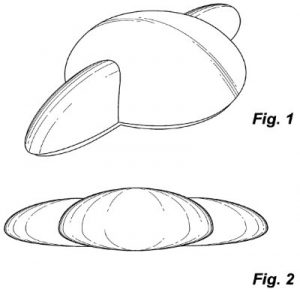 Murray’s Hamdog innovation is seen in U.S. Patent No. D584478, titled Combination Hamburger and Hotdog Bread Bun. The patent covers the design of a bread bun which is round to cover a burger pattie but also includes an elongated middle bun section to cover a hot dog running down the center of the bun. The U.S. Patent and Trademark Office issued this patent to Murray in January 2009.
Murray’s Hamdog innovation is seen in U.S. Patent No. D584478, titled Combination Hamburger and Hotdog Bread Bun. The patent covers the design of a bread bun which is round to cover a burger pattie but also includes an elongated middle bun section to cover a hot dog running down the center of the bun. The U.S. Patent and Trademark Office issued this patent to Murray in January 2009.
The USPTO’s official website notes that food products and even recipes can be patented. Patents previously granted for food products run the gamut from layered peanut butter and jelly slices to commercial processes for producing bread which can be frozen without affecting the taste. Patent applications filed for food products and recipes particularly run into Section 102 novelty and Section 103 nonobviousness issues. Recipes are typically the sum of their parts because food ingredients typically convey tastes which are expected even if the mixture seems novel; nobody else might be adding tarragon to ice cream, but the resulting taste wouldn’t be novel and unexpected. Even if a previous recipe couldn’t be found, a supposedly new recipe could be considered obvious if the prepared food relies heavily upon known food production processes. The USPTO uses an example of cracking an egg on top of a pancake while on the griddle; the resulting food might seem like a breakfast breakthrough, but it would also be an obvious production process to someone skilled in the culinary arts.
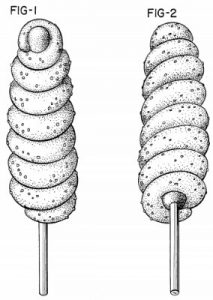 The flip side of food products requiring a higher degree of novelty and nonobviousness than other inventions is that foods which are patented are often bizarre to the imagination. Some of this off-the-wall kitchen inventiveness can be seen reflected within U.S. Patent No. D312719, titled Combined Hot Dog and Pretzel and issued to the Sara Lee Corporation in December 1990. Similar to the hamburger-hotdog combo described above, this design patent covers a hot dog on a stick, around which is wrapped a layer of pretzel dough. Although Sara Lee Corporation no longer exists after a corporate split in July 2012, this innovation continues to be marketed to American consumers by American pretzel chain Auntie Anne’s as a Pretzel Dog.
The flip side of food products requiring a higher degree of novelty and nonobviousness than other inventions is that foods which are patented are often bizarre to the imagination. Some of this off-the-wall kitchen inventiveness can be seen reflected within U.S. Patent No. D312719, titled Combined Hot Dog and Pretzel and issued to the Sara Lee Corporation in December 1990. Similar to the hamburger-hotdog combo described above, this design patent covers a hot dog on a stick, around which is wrapped a layer of pretzel dough. Although Sara Lee Corporation no longer exists after a corporate split in July 2012, this innovation continues to be marketed to American consumers by American pretzel chain Auntie Anne’s as a Pretzel Dog.
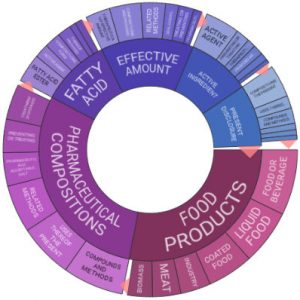 According to search results provided by the patent portfolio analysis tools available through Innography, there have been 4,179 U.S. patents issued through 2016 which are related to food. As the text cluster posted here will show readers, a great deal of food-related patents are directed to food products and pharmaceutical compositions, although there’s a fair-sized subset related to fatty acids.
According to search results provided by the patent portfolio analysis tools available through Innography, there have been 4,179 U.S. patents issued through 2016 which are related to food. As the text cluster posted here will show readers, a great deal of food-related patents are directed to food products and pharmaceutical compositions, although there’s a fair-sized subset related to fatty acids.
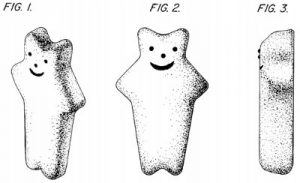 Interestingly, Murray’s Hamdog bun isn’t the only bread bun product for hamburgers which has enjoyed U.S. patent protection over the years. In May 1982, co-inventors Thomas Long and Winifred Reddick, both of Pasadena, CA, were issued U.S. Patent No. D264390, issued under the title Hamburger Bun. This elongated bun with six points, two resembling ears, two resembling arms and the other two resembling feet, is also given a face to convey some sort of character. Design patents seem to be preferred to protect food products which makes sense seeing as they’re easier to claim as novel and nonobvious than many food product compositions.
Interestingly, Murray’s Hamdog bun isn’t the only bread bun product for hamburgers which has enjoyed U.S. patent protection over the years. In May 1982, co-inventors Thomas Long and Winifred Reddick, both of Pasadena, CA, were issued U.S. Patent No. D264390, issued under the title Hamburger Bun. This elongated bun with six points, two resembling ears, two resembling arms and the other two resembling feet, is also given a face to convey some sort of character. Design patents seem to be preferred to protect food products which makes sense seeing as they’re easier to claim as novel and nonobvious than many food product compositions.
A food product for cigarette smokers who can’t light up in their current surroundings is protected by U.S. Patent No. 6749882, entitled Coffee Having a Nicotine Composition Dissolved Therein. Issued to solo inventor Stephen Fortune, Jr., of Bridgewater, MA, in June 2004, the patent covers a water soluble composition suitable for use in forming a nicotine-containing beverage including water, the composition being capable of dissolving within the beverage in less than one minute. The invention was conceived as a way of providing nicotine to a person who wishes to smoke when they are incapable of doing so, such as while traveling via public transportation. The patent’s background also considers the drawback of nicotine gum use, which can convey a poor taste and where the act of chewing can be unacceptable in certain social situations.
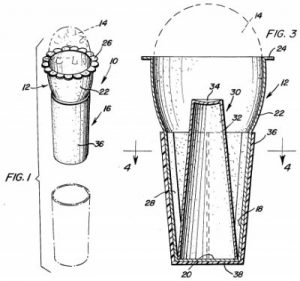 Slices of pizza are fairly portable on their own but the convenience of carrying a greasy slice gets even easier thanks to the technology outlined within U.S. Patent No. 4463021, entitled Pizza Cone with Filling. This patent was issued to solo inventor Joseph Eufemia of New Milford, NJ, in July 1984. The patent covers a handheld edible food product with an open upper end and a closed lower end to form a receptacle containing a pizza filling, and then an insulating cup of foam plastic telescoped over the lower portion of the pizza cone to protect the hand of the person holding the cone. The pizza cone can be frozen and provided with a structure so that the cone can be heated in the microwave to a desired uniform temperature without the pizza filling leaking out through the cone’s bottom. Pizza cones have made forays into the New York City market in recent years, with varying degrees of success.
Slices of pizza are fairly portable on their own but the convenience of carrying a greasy slice gets even easier thanks to the technology outlined within U.S. Patent No. 4463021, entitled Pizza Cone with Filling. This patent was issued to solo inventor Joseph Eufemia of New Milford, NJ, in July 1984. The patent covers a handheld edible food product with an open upper end and a closed lower end to form a receptacle containing a pizza filling, and then an insulating cup of foam plastic telescoped over the lower portion of the pizza cone to protect the hand of the person holding the cone. The pizza cone can be frozen and provided with a structure so that the cone can be heated in the microwave to a desired uniform temperature without the pizza filling leaking out through the cone’s bottom. Pizza cones have made forays into the New York City market in recent years, with varying degrees of success.
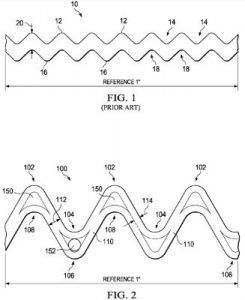 Food inventions come from large corporations and small inventor teams alike, as is evidenced by U.S. Patent No. 9462818, entitled High Amplitude Corrugated Food Product. Issued this October to the Plano, TX-based snack maker Frito-Lay, the patent covers a corrugated food product having two sides, both sides having a corrugated pattern which are substantially parallel, the product further having specific moment of inertia, dehydration factor, overall thickness and peak amplitude characteristics. The innovation answers a need for corrugated food snacks such as potato chips which create less waste byproducts during production while still resisting breakage when used with dips.
Food inventions come from large corporations and small inventor teams alike, as is evidenced by U.S. Patent No. 9462818, entitled High Amplitude Corrugated Food Product. Issued this October to the Plano, TX-based snack maker Frito-Lay, the patent covers a corrugated food product having two sides, both sides having a corrugated pattern which are substantially parallel, the product further having specific moment of inertia, dehydration factor, overall thickness and peak amplitude characteristics. The innovation answers a need for corrugated food snacks such as potato chips which create less waste byproducts during production while still resisting breakage when used with dips.

![[IPWatchdog Logo]](https://ipwatchdog.com/wp-content/themes/IPWatchdog%20-%202023/assets/images/temp/logo-small@2x.png)

![[Advertisement]](https://ipwatchdog.com/wp-content/uploads/2024/04/UnitedLex-May-2-2024-sidebar-700x500-1.jpg)
![[Advertisement]](https://ipwatchdog.com/wp-content/uploads/2024/04/Artificial-Intelligence-2024-REPLAY-sidebar-700x500-corrected.jpg)
![[Advertisement]](https://ipwatchdog.com/wp-content/uploads/2024/04/Patent-Litigation-Masters-2024-sidebar-700x500-1.jpg)

![[Advertisement]](https://ipwatchdog.com/wp-content/uploads/2021/12/WEBINAR-336-x-280-px.png)
![[Advertisement]](https://ipwatchdog.com/wp-content/uploads/2021/12/2021-Patent-Practice-on-Demand-recorded-Feb-2021-336-x-280.jpg)
![[Advertisement]](https://ipwatchdog.com/wp-content/uploads/2021/12/Ad-4-The-Invent-Patent-System™.png)






Join the Discussion
No comments yet.